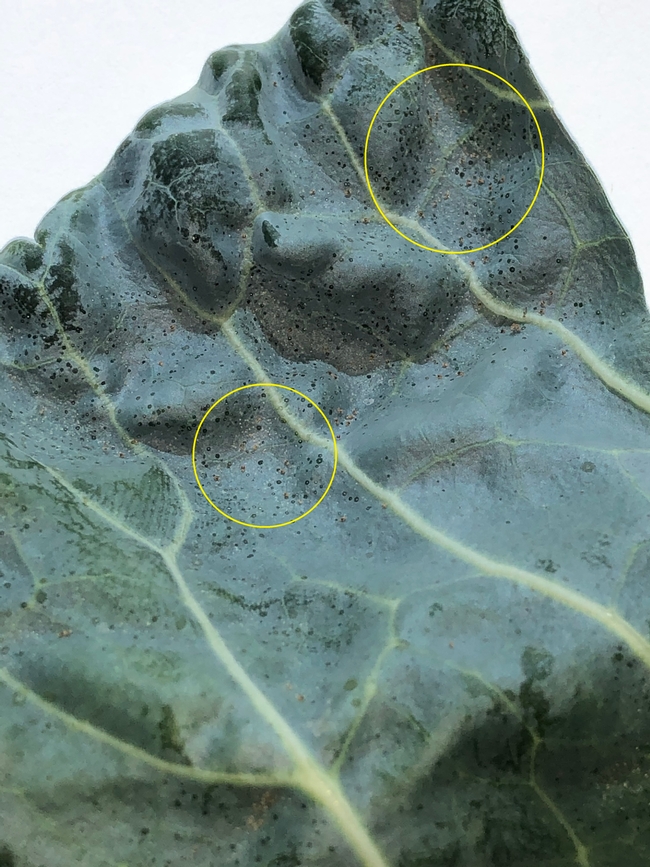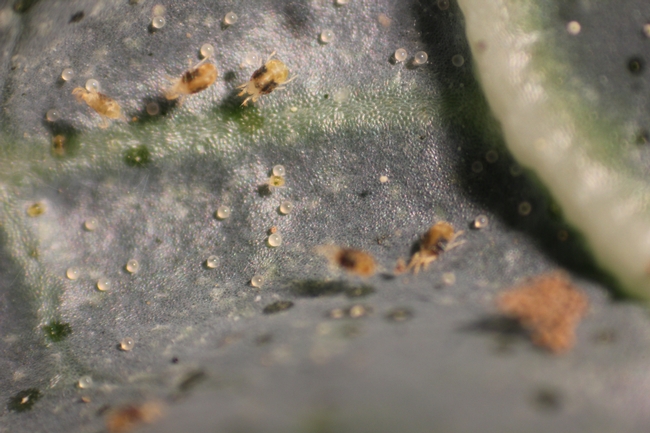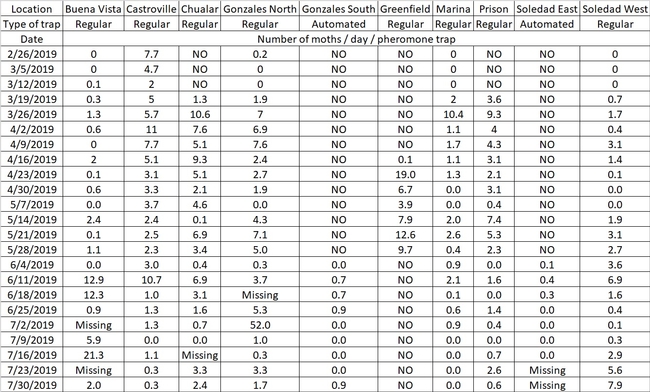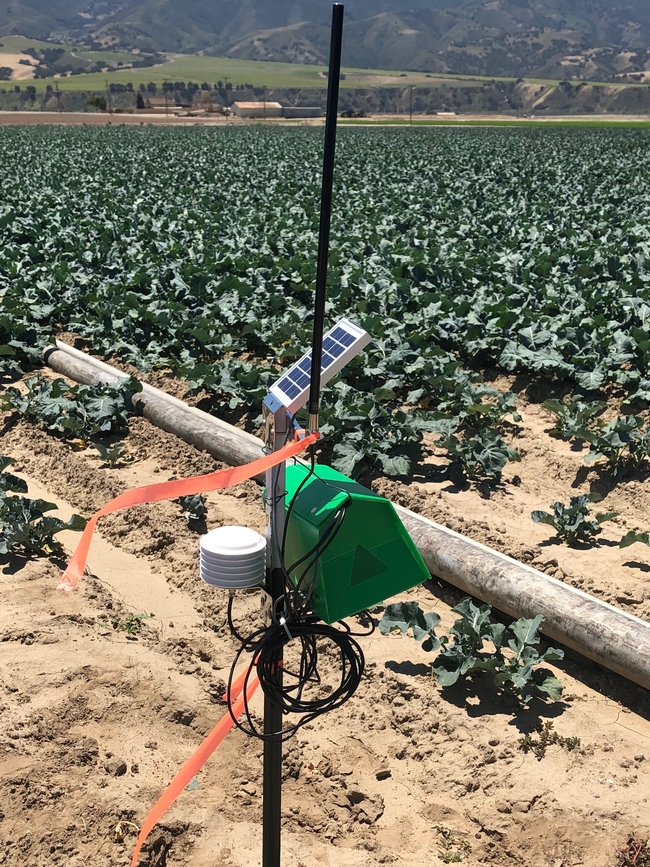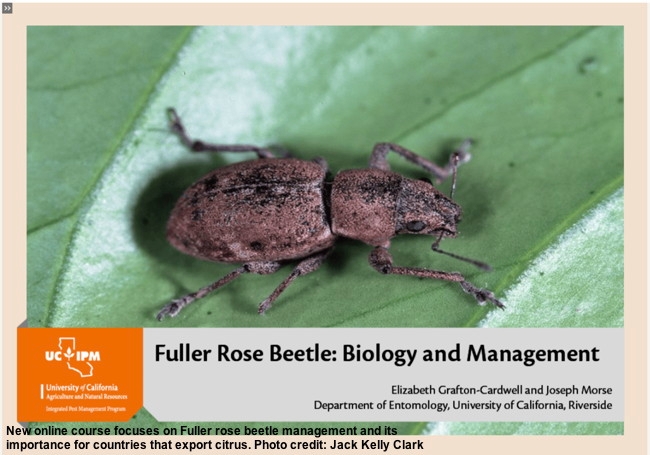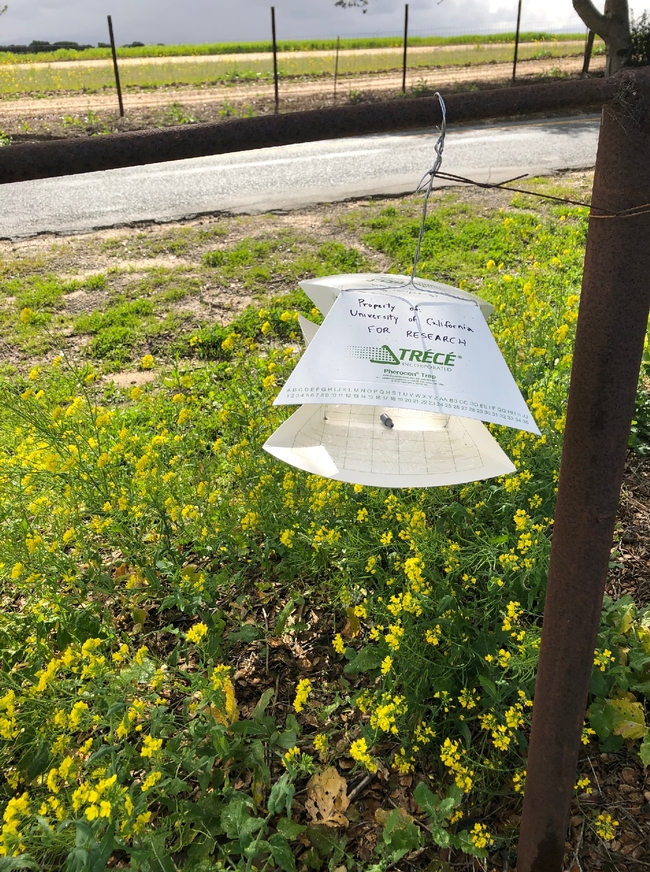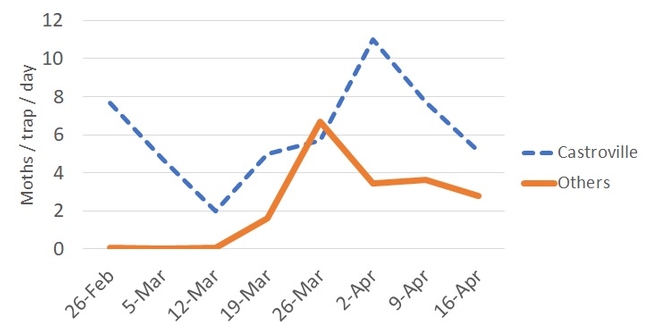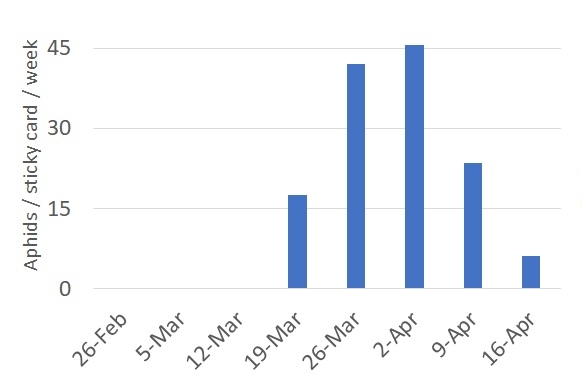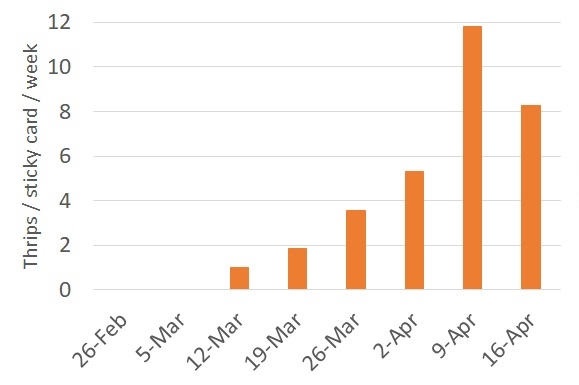- (Focus Area) Pest Management
- Author: Alejandro Del Pozo-Valdivia
On Wednesday October 9th, a Brussels sprout plant sample was submitted to our Entomology laboratory for insect identification.
At the naked eye, we observed some webbing and specks on the leaf (See Fig. 1).
Fig. 1. Leaf of Brussels sprout showing some webbing and 'specks'. Affected areas are highlighted with the yellow circles.
Under magnification, we were able to see eggs, nymphs and adults of the two spotted spider mite (TSSM), Tetranychus urticae (See Fig. 2). Adults of these specimens have the two black spots on the lateral sides of the anterior end of the podosoma, the area located below their mouth parts.
Fig. 2. Eggs, nymphs and adults of two spotted spider mites on the leaf of Brussels sprout.
TSSM is one of the most polyphagous mites, having several host plants around the world. Females disperse by putting silk strands right after mating and before producing eggs. Dispersing females climb to the top of the plant and specimens are carried out by the wind. This phenomenon called ballooning, aids mites to float through the air and disperse longer distances to reach favorable host plants.
It is highly advised that Brussels sprout growers and PCAs walking this crop, pay close attention to leaves within the canopy to potentially identify the presence of TSSW in this crop.
If you believe you may have TSSM in your Brussels sprouts, please send us a plant sample at 1432 Abbott St. in Salinas for confirming identification (free service), or call us at 831-759-7359 to obtain additional information on this pest.
- Author: Alejandro Del Pozo-Valdivia
Last year, this pest was present in large numbers during August and September. The idea is to have additional data from the pheromone traps to inform the IPM decision making process. Below is a table showing the number of moths per day and per trap since February.
Table 1. Male diamondback moth captures by pheromone traps across the Salinas Valley. There are two type of traps deployed in the fields. We have the cardboard traps labeled as 'Regular' and also the automated traps labeled as 'Automated' and shown in Fig. 1.
Fig. 1. Automated trap (provided by AgCeleration and manufactured by TrapView) in a broccoli field. This type of trap has four cameras on top of the sticky liner. Cameras will take daily pictures. Pictures are analyzed to recognize the adult of diamondback moth. This trap uses a cellular connection to transmit the pictures daily to a centralized computer. The computer will use machine learning to recognize and count new moths getting stuck onto the liner.
To put these captures on a time perspective, the below time series graph shows the fluctuation of the diamondback moth captures since we set up the traps. The below graph does not include the data from the automated traps. Capture data is broken into a series labeled 'Castroville' (dotted line) indicating the moth captures from that specific location, and a second series labeled 'Other' (solid line) where the average captures among the other locations are presented.
If you are interested in learning more about this monitoring program, please contact Alejandro Del-Pozo at adelpozo@ucanr.edu or 831-759-7359.
- Author: Cheryl Reynolds
Summer is here, and we're halfway through 2019 already! Why not get jump on finishing up your continuing education units by taking online courses from the UC Statewide IPM Program (UC IPM). If you are a license or certificate holder from the California Department of Pesticide Regulation (DPR), and your last name begins with the letters M through Z, you should be receiving your renewal packet in August.
We're excited to announce some changes.
- In January, we switched all of our online courses to a new learning system located at https://campus.extension.org/. This new system has extensive technical support, is easier to navigate, and is more stable than the old one. Note that the extension platform offers courses from all across the country, including several providers from California. Look for the UC IPM logo to be sure you are taking one of our courses.
- We are pleased to announce that a brand-new online course on the Fuller rose beetle was added to our citrus integrated pest management IPM series. Dr. Beth Grafton-Cardwell, a citrus IPM specialist and research entomologist, and Dr. Joseph Morse, emeritus professor of entomology, developed the course. The course describes the life cycle, natural enemies, and management of Fuller rose beetle and explains why it is important for countries that export citrus. Fuller Rose Beetle has been approved by (DPR) for 1 hour of credit in the Other category and by Certified Crop Advisor (CCA) for 0.5 hour of IPM credit.
- Many of our courses are now credited not only by DPR for continuing education hours, but also by the California Structural Pest Control Board (SPCB), Certified Crop Advisor (CCA), Western Chapter of the International Society of Arboriculture (WCISA), and also by Arizona Department of Agriculture.
DPR encourages license and certificate holders to avoid the end-of-the-year rush and submit renewal applications by November 1 to ensure license renewal by January 1, 2020. Submitting your renewal early avoids late fees and gives you time to address any issues that may arise such as not having enough hours to successfully renew.
Another incentive to get a jump on completing your needed continuing education units (CEUs) with UC IPM's online courses is that we are offering an early-bird price for four of our most wanted courses until November 1st.
- Proper Pesticide Use to Avoid Illegal Residues (2 hours Laws and Regulations; early bird price $40, full price $80)
- Proper Selection, Use, and Removal of Personal Protective Equipment (1.5 hours Laws and Regulations; early bird price $30, full price $60)
- Pesticide Resistance (2 hours Other; early bird price $20, full price $40)
- Pesticide Application Equipment and Calibration (1.5 hours Other; early bird price $15, full price $30)
You can find all of our twenty-one courses listed on the UC IPM website at http://ipm.ucanr.edu/training/.
- Author: Alejandro Del Pozo-Valdivia
We are happy to announce that the diamondback moth capture data, presented as maps, is now housed in our own University of California Cooperative Extension Monterey website.
To access to these maps, simply click on the link below:
http://cemonterey.ucanr.edu/Agriculture/2019_Diamondback_moth_monitoring_maps/
These maps use the closest town or landmark where the traps are located to show moths per trap per day. Moth captures are presented as yellow bubbles. The bigger the bubble, the larger the population of moths is.
On the same page, you will also find the overall population fluctuations of these moths in the Valley, as a series chart.
We also stored the overall fluctuation of aphids and thrips numbers, captured in yellow sticky cards in our UCCE Monterey website. To access to these bar charts, click on the link below:
http://cemonterey.ucanr.edu/Agriculture/2019_Aphid_and_Thrips_Monitoring_Program/
If you would like to learn more about these three monitoring programs happening in the Salinas Valley, do not hesitate to contact Alejandro Del-Pozo at adelpozo@ucanr.edu or 831-759-7359.
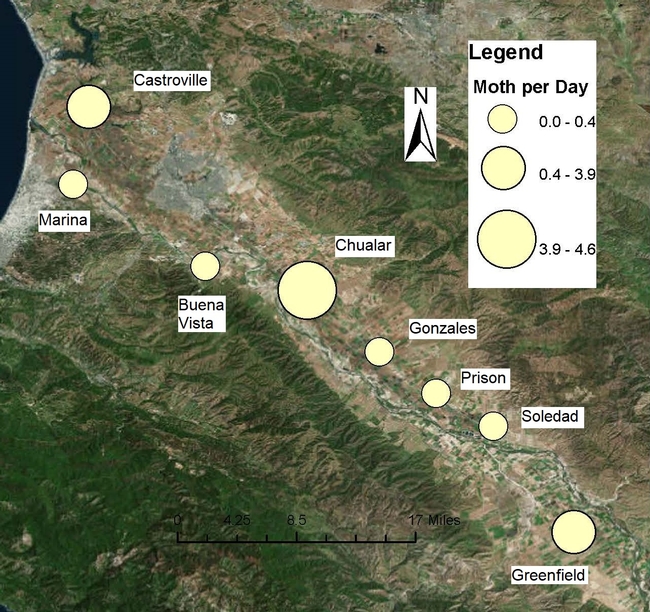
- Author: Alejandro Del Pozo-Valdivia
We continue the effort of monitoring diamondback moth (DBM) across the Salinas Valley using sex pheromone baited traps, as shown in the picture above. We have been adding additional traps to cover a larger area along Highway 101. We have daily moth capture data from Castroville to Greenfield. The chart below summarizes these daily captures from our pheromone traps.
As stated in a previous blog post, higher numbers of DBM have been usually recorded in Castroville. It seems like we just passed a generation of adults during late March to early April. Currently, DBM capture numbers are going down. Lower adults in the system could be paired with more caterpillars feeding on several host plants.
We have set up yellow sticky cards to track the overall population of winged aphids and thrips. These sticky cards are in the same locations as the pheromone traps. At this point, data for aphids and thrips is not broken down at the species level.
From the chart above, there was a flight of aphids during late March to early April. Some PCAs mentioned to me that foxglove aphid started to show up in their fields during that time period. It seems now that winged aphid numbers are going down. However, it does not mean that numbers of aphids in our crops are decreasing. We might be facing higher population of wingless aphids in our crops right now.
We need to keep an eye on population dynamics of thrips in the Valley. The ultimate goal is to be better prepared this season to manage those creatures and reduce the incidence of INSV virus. The chart below shows captures of thrips in our sticky cards.
It seems like thrips populations had a spike two weeks ago. Currently, thrips numbers are going down. I believe that keeping track of the fluctuation of thrips numbers in our Valley would help us detect large populations of this pest. There is a need to alert PCAs when the front of a 'thrips wave' would happen.
If you are interested in getting more information on this monitoring effort, please do not hesitate in contacting Alejandro Del-Pozo at 831-759-7359 or adelpozo@ucanr.edu.

